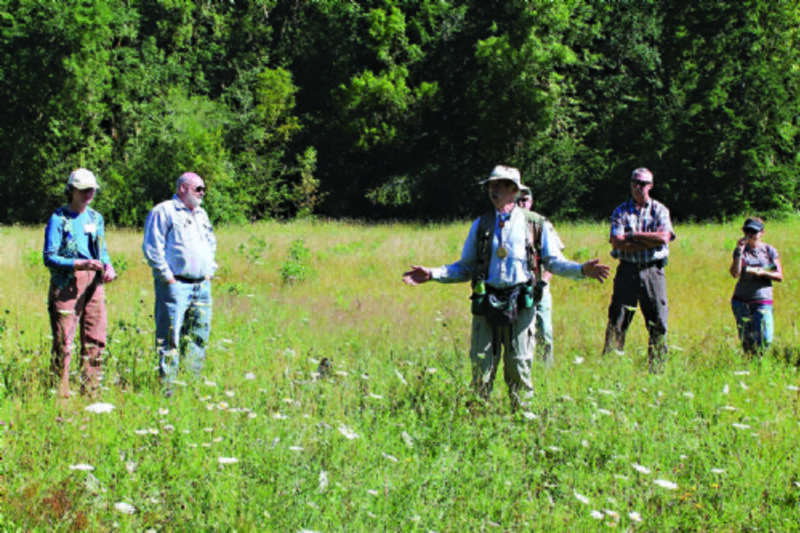Sean C. Morgan
The U.S. Forest Service Sweet Home Ranger District is looking for input from the public to help develop a land management plan for the Trout Creek drainage.
The Ranger District will complete a similar plan for the Cool Soda Planning Area, including the Cool Camp and Soda Fork areas, this year.
The goal is to get public comments early on in the process to help design individual projects to meet a variety of district objectives, engaging as many interests in the land as it can, private timber, conservation, recreation, the public and other agencies.
The Trout Creek Planning Area is 37,212 acres. Some 16.5 percent of it is private land, and the Forest Service maintains roads in the area in an agreement with Cascade Timber Consulting, which manages most of the private land.
Some 40.4 percent of the area is roadless, and it contains critical northern spotted owl habitat. About 38.5 percent of the land is in adaptive management, which allows the Forest Service to experiment with different treatments to attain its goals; and 21.5 percent is late successional reserve or old growth.
Land management requires a series of tradeoffs, and the district’s goal is to analyze the needs of the land and then plan projects where they will provide the most benefit for meeting those needs.
Linking together ecological, social and economic goals, the area contains many potential restoration opportunities, including sugar pine, meadow enhancement, oak and madrone trees and huckleberries. Adaptive management provides opportunities to initiate research for the Institute for Working Forest Landscapes.
The plan may help the district, which is selling about 8 million board feet per year, meet targets for timber and other resources. It can also serve as a connection point to the Community Forest Corridor Project, which aims to link the city of Sweet Home to the Willamette National Forest through the creation of a trail.
Public officials and private landowners also are interested in planning for fire management and control. In the Menagerie Wilderness, partially located in the drainage, fire isn’t extinguished. But private timber managers, like Cascade Timber Consulting, aggressively fight fires to protect valuable trees, which means they are interested in fire breaks. Wildlife corridors in the Cool Soda area help provide that while giving deer and elk better forage and keeping them away from seedlings there.
After the plan is complete, individual projects must follow the National Environmental Policy Act process, and smaller projects could begin as early as next summer.
“We’re going to come up with objectives we’re going to try to feature in this landscape,” said District Ranger Cindy Glick. “It takes a whole lot of heads to solve problems.”
The Sweet Home Ranger District hosted a field trip, with about 25 persons participating, into the Trout Creek drainage to discuss ideas on Thursday.
The tour stopped first at the camas prairie off Moose Mountain Road, used by native Americans to harvest camas, a traditional food, for nearly two decades. The prairie is burned every other year to promote cultivation of the camas.
The site also included an area popular for its dispersed camping along the South Santiam River.
“We all know that outdoor recreation is fun,” Glick said. Campers get the opportunity to learn new skills, bond with family and friends and enjoy the outdoors.
At that site, forest officials often hear from people who want to use the river access for swimming, but campers are often in the way, said district Hydrologist Lance Gatchell.
Camping etiquette requires permission to pass through a camp, said Milt Moran, vice president with CTC, and it would be good to find a way to allow day use as well as camping at the location.
The second and third stops were in adaptive management areas featuring 120-year-old stand replacements that characterize 44 percent of the Planning Area following fire in 1856. Since then, the Forest Service has fought fire, impacting the forest in different ways in each area.
Because it hasn’t had fire while growing, the land is much like a “stem exclusion” zone, where there is little opportunity for new plants and trees to grow, said Allan Braun, district forester. That causes more risk from major disturbances, like bug infestations, drought and lack of species and habitat diversity.
“It’s probably our most controversial age,” Braun said. “It’s not plantation, and it’s not old growth.”
The idea of adaptive management is to springboard the development of late successional reserves, said Anita Leach, district planner.
To meet goals and research forest practices, Oregon Wild Field Coordinator Chandra LeGue suggested learning from treatment areas small.
The fourth stop was at the new pipe off Gordon Road used to put spring Chinook and winter steelhead above Foster Dam and a primarily alder stand that is likely to reach the end of its natural life in about 20 years.
The Ranger District wants to hear ideas, Braun said. The stand could end up falling into a brushy field. It’s at a good size for harvest, but the question is what to do with it later on.
“This is really meant to be a landscape-level sort of project,” Glick said. The district wants every idea it can collect to help it determine how to manage the land.
“Give us your ideas and stay tuned,” she said.
For more information, contact the Ranger District at (541) 367-5168.





